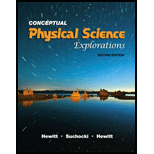
Concept explainers
The solar system is like an atom in that both
(a) are governed principally through the electric force.
(b) consist of a central body surrounded by objects moving in elliptical paths.
(c) are composed of plasma.
(d) are mainly empty space.
The correct option for the statement “The solar system is like an atom in that both”
Answer to Problem 2RAT
The correct option for the statement “The solar system is like an atom in that both” is option (b).
Explanation of Solution
In the solar system, the planets are bound to the Sun by the gravitational forces of attraction. All the planets revolve around in elliptical orbits.
On the other hand, the electrons also revolve around the nucleus in an elliptical orbit. The electrons are bound to the nucleus by the electrostatic force of attraction. The only similarity the atomic structure is having with the solar system is that there is a huge mass at the center.
For the solar system, the huge mass at the center is Sun and for the atomic structure, the huge mass at the center is mass of the nucleus.
Conclusion:
Therefore, the correct option for the statement “The solar system is like an atom in that both” is option (b).
Chapter 32 Solutions
Conceptual Physical Science Explorations
Additional Science Textbook Solutions
Conceptual Physics (12th Edition)
Physics for Scientists and Engineers with Modern Physics
Cosmic Perspective Fundamentals
Introduction to Electrodynamics
Physics for Scientists and Engineers: A Strategic Approach with Modern Physics (4th Edition)
Physics for Scientists and Engineers: A Strategic Approach, Vol. 1 (Chs 1-21) (4th Edition)
 College PhysicsPhysicsISBN:9781305952300Author:Raymond A. Serway, Chris VuillePublisher:Cengage Learning
College PhysicsPhysicsISBN:9781305952300Author:Raymond A. Serway, Chris VuillePublisher:Cengage Learning University Physics (14th Edition)PhysicsISBN:9780133969290Author:Hugh D. Young, Roger A. FreedmanPublisher:PEARSON
University Physics (14th Edition)PhysicsISBN:9780133969290Author:Hugh D. Young, Roger A. FreedmanPublisher:PEARSON Introduction To Quantum MechanicsPhysicsISBN:9781107189638Author:Griffiths, David J., Schroeter, Darrell F.Publisher:Cambridge University Press
Introduction To Quantum MechanicsPhysicsISBN:9781107189638Author:Griffiths, David J., Schroeter, Darrell F.Publisher:Cambridge University Press Physics for Scientists and EngineersPhysicsISBN:9781337553278Author:Raymond A. Serway, John W. JewettPublisher:Cengage Learning
Physics for Scientists and EngineersPhysicsISBN:9781337553278Author:Raymond A. Serway, John W. JewettPublisher:Cengage Learning Lecture- Tutorials for Introductory AstronomyPhysicsISBN:9780321820464Author:Edward E. Prather, Tim P. Slater, Jeff P. Adams, Gina BrissendenPublisher:Addison-Wesley
Lecture- Tutorials for Introductory AstronomyPhysicsISBN:9780321820464Author:Edward E. Prather, Tim P. Slater, Jeff P. Adams, Gina BrissendenPublisher:Addison-Wesley College Physics: A Strategic Approach (4th Editio...PhysicsISBN:9780134609034Author:Randall D. Knight (Professor Emeritus), Brian Jones, Stuart FieldPublisher:PEARSON
College Physics: A Strategic Approach (4th Editio...PhysicsISBN:9780134609034Author:Randall D. Knight (Professor Emeritus), Brian Jones, Stuart FieldPublisher:PEARSON





